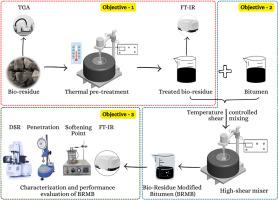处理后的生物渣油作为沥青改性剂的初步评价
IF 5.8
2区 化学
Q2 CHEMISTRY, MULTIDISCIPLINARY
引用次数: 0
摘要
随着全球向可持续建筑实践的转变,有机工业副产品在路面应用中的再利用正在获得动力。如果处理得当,生物残留物可以作为传统粘合剂的环保替代品。本研究提出了一个初步的调查,使用热处理后的咖啡因废渣(CSR)作为粘合剂配方中沥青的部分替代品。CSR来源于有机工业废料,经过热预处理以改善与沥青相的相容性。然后将处理后的CSR与沥青(VG-40)混合,使用实验室规模的高剪切混合器将其替换为不同重量水平(0%、3%、6%、9%、12%和15%),以生产生物渣油改性沥青(BRMB)。所得到的BRMB样品通过渗透和软化点测试进行评估,并使用Superpave车辙参数(G∗/sin δ)进行流变学表征,以评估处理后的CSR对基本粘合剂性能的影响。对未老化和rtfo老化样品进行分析,以捕捉短期老化对一致性和车辙抗性的影响。此外,从摇篮到门的隐含能量(EE)和隐含碳(EC)评估显示,用处理过的CSR取代10%的沥青,显著降低了每公斤粘合剂的能耗和碳排放量。研究结果表明,处理后的CSR,特别是在9 - 10%的替代水平下,为提高沥青粘合剂的可持续性提供了一条有希望的途径。本文章由计算机程序翻译,如有差异,请以英文原文为准。

Preliminary evaluation of treated bio-residue as a modifier for bitumen
With the global shift toward sustainable construction practices, the reuse of organic industrial by-products in pavement applications is gaining momentum. Bio-residues, when appropriately treated, can serve as eco-friendly alternatives to conventional binders. This study presents a preliminary investigation into the use of thermally treated Caffeine Spent Residue (CSR) as a partial replacement for bitumen in binder formulations. The CSR, derived from organic industrial waste, underwent thermal pretreatment to improve compatibility with the bituminous phase. The treated CSR was then mixed with bitumen (VG-40) by replacing it at varying levels—0 %, 3 %, 6 %, 9 %, 12 %, and 15 % by weight using a laboratory-scale high-shear mixer to produce Bio-residue Modified Bitumen (BRMB). The resulting BRMB samples were evaluated through penetration and softening point tests, along with rheological characterization using the Superpave rutting parameter (G∗/sin δ) to assess the influence of treated CSR on fundamental binder properties. Both unaged and RTFO-aged samples were analyzed to capture the impact of short-term ageing on consistency and rutting resistance. Additionally, a cradle-to-gate assessment of embodied energy (EE) and embodied carbon (EC) revealed that replacing 10 % of bitumen with treated CSR significantly reduced the energy consumption and carbon emissions per kilogram of binder. The findings establish that treated CSR, particularly at a 9–10 % replacement level, offers a promising pathway for enhancing the sustainability of bituminous binders.
求助全文
通过发布文献求助,成功后即可免费获取论文全文。
去求助
来源期刊

Sustainable Chemistry and Pharmacy
Environmental Science-Pollution
CiteScore
8.20
自引率
6.70%
发文量
274
审稿时长
37 days
期刊介绍:
Sustainable Chemistry and Pharmacy publishes research that is related to chemistry, pharmacy and sustainability science in a forward oriented manner. It provides a unique forum for the publication of innovative research on the intersection and overlap of chemistry and pharmacy on the one hand and sustainability on the other hand. This includes contributions related to increasing sustainability of chemistry and pharmaceutical science and industries itself as well as their products in relation to the contribution of these to sustainability itself. As an interdisciplinary and transdisciplinary journal it addresses all sustainability related issues along the life cycle of chemical and pharmaceutical products form resource related topics until the end of life of products. This includes not only natural science based approaches and issues but also from humanities, social science and economics as far as they are dealing with sustainability related to chemistry and pharmacy. Sustainable Chemistry and Pharmacy aims at bridging between disciplines as well as developing and developed countries.
 求助内容:
求助内容: 应助结果提醒方式:
应助结果提醒方式:


